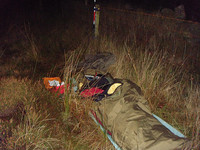Portable ham radio operating at night
Posted by Richard G3CWI on 30th Oct 2014
With winter fast approaching the hours of daylight are dwindling here in northern Europe. Shorter days might mean less time for lightweight portable operating - but they don't have to. Portable operating at night can turn a trip to a familiar location into a real adventure.
For your first night-time trip I suggest you choose somewhere that you know well and that is straightforward to reach. Even familiar places can look very different at night and getting lost is not part of the plan.
Obviously your first thoughts will turn to lights. Modern LED lighting is bright and efficient. A head-torch is most useful as it leaves your hands free. There is no need to spend a fortune and a brightness of around 100 lumens will be fine for most applications.Much brighter lights are available but they get through batteries faster. When selecting a head torch look for one that wont switch on accidentally in your pack. Ideally look for one that includes a red LED mode. I recommend carrying a spare torch and batteries too as getting stuck on a hill in the dark with no torch could be dangerous.
For you first trip, reconnect with nature by selecting a clear night with a full-moon. This will make everything so much easier. For your approach walk, there are two possible ways to do things: just turn on the torch and walk is the most obvious. More rewarding however is to let your eyes adjust to the dark (takes around 20 minutes) and walk in without a torch. This is where the red light on your torch comes in handy as you can use the dim red light to check maps and even light the way without ruining your night vision. Oh - and turn the screen light right down on your mobile phone and GPS; they will ruin your night vision. In the dark, the world will look rather monochrome and you will see distant lights that will get you wondering just where they are.
Walking at night in the hills is a wonderful thing. Everyone should try it at least once! It is especially good with a full moon in the snow. Moonlight twinkling off crystals of fresh snow is something very special.
Some things to consider for your first night activation are to choose an antenna that will be easy to set up and take down. Night ops are not the time to try something new. Turn down the brightness of the dial lights on your radio if possible. Remember that the night gives you the chance to try out some different bands. 80m is fun if you can manage to set up a low dipole. Once word gets around you will be in demand on the band. Take plenty of warm clothes and a warm drink too - it can get mighty cold on a clear moonlit night in the winter.

Night-time 80m SOTA activation
Don't forget safety. Let someone know where you are going and when you are expected back. Choose a walk in that you know is simple and safe - for example, avoid cliff edges. Choose an area where you will be safe from others too: my experience is that there are many more people out at night than you might expect.
Another variation worth considering is an "overnighter". I will perhaps give some tips on that later.
________________________
Richard G3CWI is CEO of SOTABEAMS, a company that specialises in helping radio amateurs to take their radio into the great outdoors.
****************************************************************
Comments from readers:
______________________
I enjoyed your articles on hotel and night ops.
A constructive comment: I am concerned about the risk of people putting up antennas in the dark, and being oblivious to power-lines. Even if they know the site, I guess there is always a small risk that a temporary (builder's?) power-line might have been suspended since their previous day-light visit.
I'm not sure how to advise, but thought it was worth mentioning.
Tim
G4DBL
___________________
Mark Janzer wrote:
I’d like to comment on the operating at night blog entry:
I’ve found that bringing and laying down a small tarp/rain fly (or small table cloth) helps to avoid losing small bits and pieces (like connector adapters) in the grass.
They’re much harder to find in the dark, and chew up time that could be spent operating rather than searching.
_____________
Good article, the only thing I would add is take some cylums( glow sticks) and add them to the antenna. That way people (if any) will not walk into them. Small ones used by fishermen are ideal



